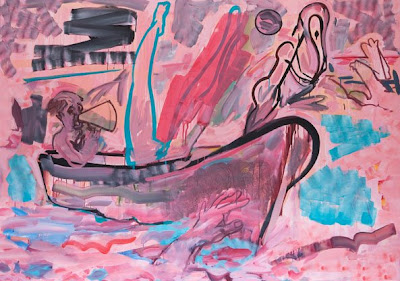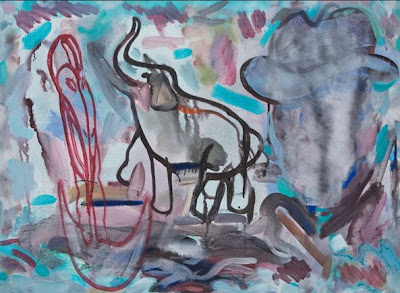From Brian Johns
Opening at the Wilson Street Gallery on 29 March is The Ship of Fools by Newtown identity and artist of renown Bill Brown. Currently a lecturer at the National Art School, Brown has been exhibiting since the 1960s and has more than 20 solo shows to his credit with works held in most major Australian collections…

Bill Brown, Ship of Fools, 2008.
Acrylic on canvas, dimensions unknown.
How did the boy from Cowra land in the famous art school in East Sydney?
Bill Brown: I think it’s a consequence of being pointed that way as a child. Neighbours, aunties, family were all hanging things on the wall. When I was fifteen at school I was given a chance of going on further academically or getting a job. When it came to my turn the words just spat out, “I am going to be artist”. So that was where I began . I was just fifteen sitting doing the (National Art School) test and I was accepted. And I landed a job at the first place I tried which was J. Walter Thompson – a big advertising agency. It was an amazing experience – I learned standards by doing things again. Once I made a mistake and the art buyer said, “you don’t really want me to put a ruler on that line do you?”. And I said “no”. And so you go back and do it again. It was a discipline in business. I also learned from working with the layout artists. A sheet of words was the basis of the whole campaign – and they would have to visualize it. I watched the way these guys generated. Start off with a small core – a small idea. It just expands.
The fact is too that it would have been task orientated wouldn’t it? You got a job and you had to complete a job. Did that help your painting?
BB: I would like to say “yes” but I’m not sure. I am stubborn. I see things through. I’ve learned that.
And it was a great time…
BB: Yes it was so exciting. The 60’s were wonderful. They were about change and revolution. There was the Rolling Stones, Bob Dylan, the Vietnam War. It was a very changing time. And it was a very rich time, for the heart. We had the London exhibitions of Australian paintings at the Tate Gallery and the Whitechapel show. People were beginning to notice. We had commercial galleries starting to open up and mushroom. It seemed to me that art, of all cultural activity, was ahead of the game. In terms of the questions we were asking, like Australian identity, art was making it in a way.
So who were your influences at art school?
BB: There were just a few familiar models like Nolan and Fairweather. These were the artists I identified with – the Australian ones. Godfrey Miller would have been a teacher at the National. I studied in his evening classes in 1964 and the whole fine art world opened up to me. I saved my money and quit my job, against all the best advice.
That’s brave.
BB: Well, it’s the lure that I couldn’t resist. I can’t explain how a 17 year-old has these feelings for fine art. And then makes a decision against all the advice. I would say it was like a calling.
You seemed to have had a strong social dimension to your thinking. Was it broadly political or social?
BB: Yes I think it was broadly political. What I want to do in my art is to show humanity. When I left commercial art, I left behind the idea of business. If I had stayed in that business, I would have had success as it is measured now.
And you never looked back?
BB: Oh no. No regrets. This is my life. What I have done is teach as a way of funding the private side.
You began showing early.
BB: Yes. I showed with Rudy Komon when I was 22. I showed with Bonython. I showed with Macquarie Galleries. I showed with Rex Irwin. I have shown with the best galleries. It was a time when Fred Williams, John Brack., Arthur Boyd, Colin Lanceley, Jan Senbergs, Robert Klippel were hitting their straps in one gallery or another, mainly Rudy actually.

Bill Brown, Puff, 2008.
Acrylic on canvas, dimensions unknown.
Is drawing important to you?
BB: There are two sides to that– there’s drawing as an end in itself which captures expression and a quick observation. And then there is drawing that is a means to an end. Almost all of these paintings come from drawings and that’s what I work from. I think my ability to draw is what makes me paint the way I do.
So are these paintings autobiographical?
BB: They are. They exist primarily for me to build meaning in my life. I appear in all of them. I have never really tackled portraiture as an issue as I never wanted to capture likeness. But I see myself as being so much a part of the painting now that I put myself next to whatever it is that is going on.
The colours are very vivid. Not having seen your work for a while, is this something of a departure or a development?
BB: I think everything is a departure and a development. It is like the boat – that is also part of it – the arriving and the departing. The Ship of Fools is just a box that I put things from my life in and plonked it on a rough sea. But you can’t be too literal. They are held together by their visuals.
Accepting that, it seems to me that older painters strike out, they suddenly strike out. I’m thinking Lloyd Rees – he suddenly struck out of his pattern. Kevin Connor is another – it seems to me that he is using stronger colour. And I wonder if that comes with maturity or age?
BB: It does. There is a loss of detail, your vision. And you feel confident about it. There comes a point when you are actually ahead of your experience and so you are then forced to make imaginative leaps. Surprisingly they work. And if they don’t work you go back and revisit. So there is always a breakdown of belief, and a breakthrough.
Do you think that these paintings are more interior?
BB: Yes, very much, it is a very interior space now.
Do you think that comes with age?
BB: I am at an age now that I am not embarrassed by it. That’s important.
What do you think we need as people who are interested?
BB: I think it gives us air – expanding the imaginative side. It gives form to fiction.
Tell me about that.
BB: I made my breakthrough in painting when I understood that it was all an illusion. Then the whole thing became real. That sounds like a paradox. But it’s true. And once it became that real, then I could enter into this world whenever I liked to. When you go to the cinema, you know that you are not just in that theatre. You are in the film. That’s how I am when I am in the pictures. When I am painting, I am in there with them. I am carried away. I talk to them. I question them. Subjective and objective.
So your craft. Are you still learning?
BB: I’m watching. I’m watching what I do. There’s more play in my work now. That’s the breakthrough. Things have become, in a sense, free.
It’s interesting that both Godfrey Miller and Fairweather were in a sense outsiders. Was it not only their art that interested you? Was it the way they lived?
BB: Yes I think that’s so. I could never stand attention to, or hold the line with ‘isms’, business, or extrinsic measure.
Is that another way of saying that you were not going to be captive of any school or group?
BB: I couldn’t hold the line. I couldn’t believe in it. I could hear what they were saying, and I have learnt the lessons from it, but I could never say that I actually represented something. In fact, I have chosen not to. That’s about the flow.
Do you think that comes with maturity?
BB:Yes, yes it does. If it’s not time and maturity, then what is it? All you can do is work.
So are you looking forward to this exhibition?
BB: Yes I am. It will put an end to a time, and something new will begin. They’re complex works. They involve a wrestling with some sort of vision of life. They seem playful but they do have a pessimistic side, there is a leaving as well as an arriving. The Ship of Fools is a metaphor for us all.
